Zhe-Ming Lu
Improving Skeleton-based Action Recognition with Interactive Object Information
Jan 09, 2025Abstract:Human skeleton information is important in skeleton-based action recognition, which provides a simple and efficient way to describe human pose. However, existing skeleton-based methods focus more on the skeleton, ignoring the objects interacting with humans, resulting in poor performance in recognizing actions that involve object interactions. We propose a new action recognition framework introducing object nodes to supplement absent interactive object information. We also propose Spatial Temporal Variable Graph Convolutional Networks (ST-VGCN) to effectively model the Variable Graph (VG) containing object nodes. Specifically, in order to validate the role of interactive object information, by leveraging a simple self-training approach, we establish a new dataset, JXGC 24, and an extended dataset, NTU RGB+D+Object 60, including more than 2 million additional object nodes. At the same time, we designe the Variable Graph construction method to accommodate a variable number of nodes for graph structure. Additionally, we are the first to explore the overfitting issue introduced by incorporating additional object information, and we propose a VG-based data augmentation method to address this issue, called Random Node Attack. Finally, regarding the network structure, we introduce two fusion modules, CAF and WNPool, along with a novel Node Balance Loss, to enhance the comprehensive performance by effectively fusing and balancing skeleton and object node information. Our method surpasses the previous state-of-the-art on multiple skeleton-based action recognition benchmarks. The accuracy of our method on NTU RGB+D 60 cross-subject split is 96.7\%, and on cross-view split, it is 99.2\%.
Prompt-based test-time real image dehazing: a novel pipeline
Oct 08, 2023Abstract:Existing methods attempt to improve models' generalization ability on real-world hazy images by exploring well-designed training schemes (e.g., cycleGAN, prior loss). However, most of them need very complicated training procedures to achieve satisfactory results. In this work, we present a totally novel testing pipeline called Prompt-based Test-Time Dehazing (PTTD) to help generate visually pleasing results of real-captured hazy images during the inference phase. We experimentally find that given a dehazing model trained on synthetic data, by fine-tuning the statistics (i.e., mean and standard deviation) of encoding features, PTTD is able to narrow the domain gap, boosting the performance of real image dehazing. Accordingly, we first apply a prompt generation module (PGM) to generate a visual prompt, which is the source of appropriate statistical perturbations for mean and standard deviation. And then, we employ the feature adaptation module (FAM) into the existing dehazing models for adjusting the original statistics with the guidance of the generated prompt. Note that, PTTD is model-agnostic and can be equipped with various state-of-the-art dehazing models trained on synthetic hazy-clean pairs. Extensive experimental results demonstrate that our PTTD is flexible meanwhile achieves superior performance against state-of-the-art dehazing methods in real-world scenarios. The source code of our PTTD will be made available at https://github.com/cecret3350/PTTD-Dehazing.
Accurate and lightweight dehazing via multi-receptive-field non-local network and novel contrastive regularization
Sep 28, 2023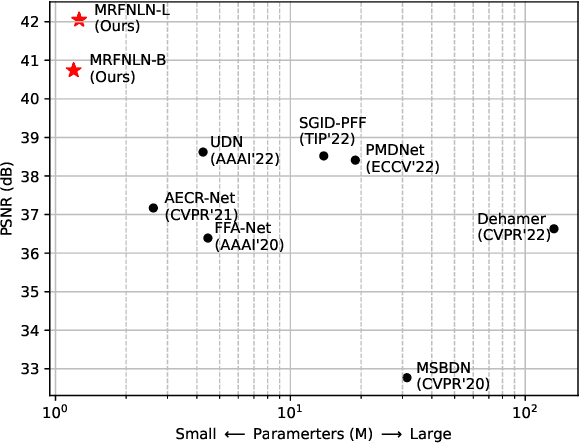
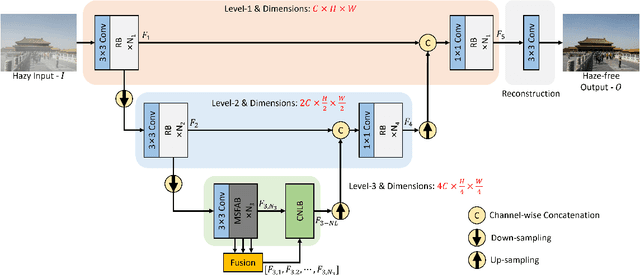
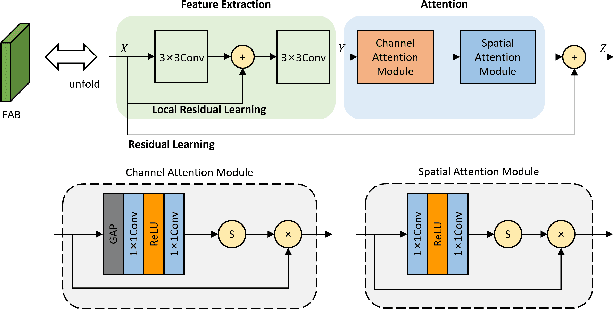
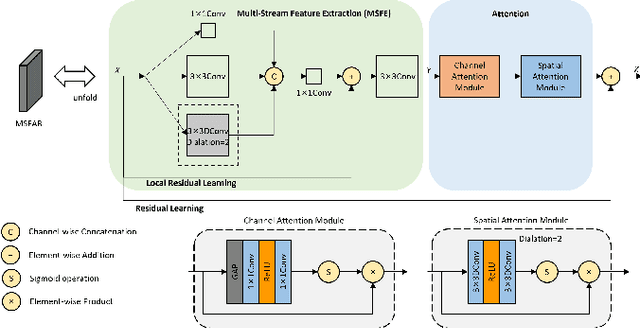
Abstract:Recently, deep learning-based methods have dominated image dehazing domain. Although very competitive dehazing performance has been achieved with sophisticated models, effective solutions for extracting useful features are still under-explored. In addition, non-local network, which has made a breakthrough in many vision tasks, has not been appropriately applied to image dehazing. Thus, a multi-receptive-field non-local network (MRFNLN) consisting of the multi-stream feature attention block (MSFAB) and cross non-local block (CNLB) is presented in this paper. We start with extracting richer features for dehazing. Specifically, we design a multi-stream feature extraction (MSFE) sub-block, which contains three parallel convolutions with different receptive fields (i.e., $1\times 1$, $3\times 3$, $5\times 5$) for extracting multi-scale features. Following MSFE, we employ an attention sub-block to make the model adaptively focus on important channels/regions. The MSFE and attention sub-blocks constitute our MSFAB. Then, we design a cross non-local block (CNLB), which can capture long-range dependencies beyond the query. Instead of the same input source of query branch, the key and value branches are enhanced by fusing more preceding features. CNLB is computation-friendly by leveraging a spatial pyramid down-sampling (SPDS) strategy to reduce the computation and memory consumption without sacrificing the performance. Last but not least, a novel detail-focused contrastive regularization (DFCR) is presented by emphasizing the low-level details and ignoring the high-level semantic information in the representation space. Comprehensive experimental results demonstrate that the proposed MRFNLN model outperforms recent state-of-the-art dehazing methods with less than 1.5 Million parameters.
A Monkey Swing Counting Algorithm Based on Object Detection
Mar 12, 2023Abstract:This paper focuses on proposing a deep learning-based monkey swing counting algorithm. Nowadays, there are very few papers on monkey detection, and even fewer papers on monkey swing counting. This research focuses on this gap and attempts to count the number of monkeys swinging their heads by deep learning. This paper further extends the traditional target detection algorithm. By analyzing the results of object detection, we localize the monkey's actions over a period of time. This paper analyzes the task of counting monkey head swings, and proposes the standard that accurately describes a monkey swinging its head. Under the guidance of this standard, the head-swing count in 50 monkey movement videos in this paper has achieved 94%.
DEA-Net: Single image dehazing based on detail-enhanced convolution and content-guided attention
Jan 12, 2023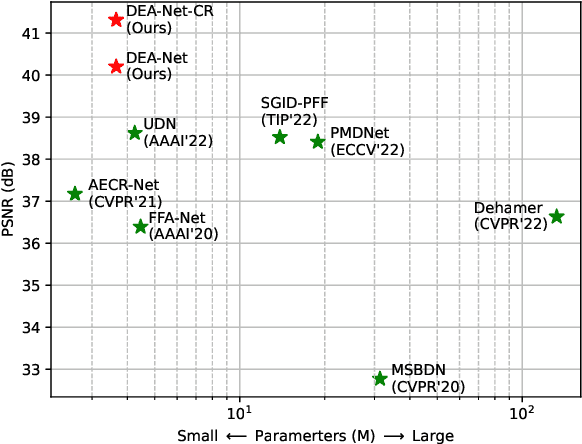
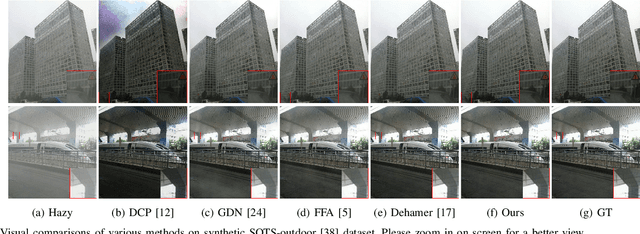
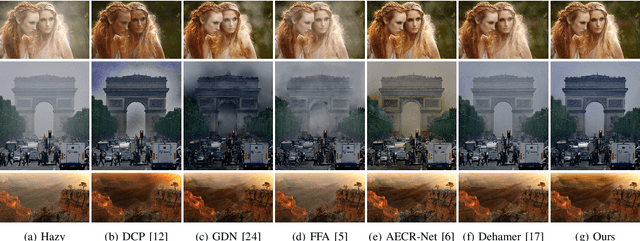
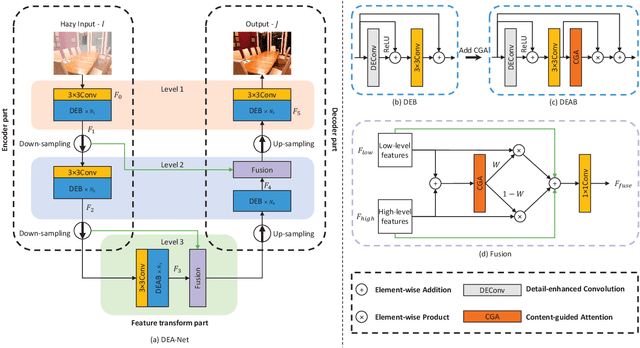
Abstract:Single image dehazing is a challenging ill-posed problem which estimates latent haze-free images from observed hazy images. Some existing deep learning based methods are devoted to improving the model performance via increasing the depth or width of convolution. The learning ability of convolutional neural network (CNN) structure is still under-explored. In this paper, a detail-enhanced attention block (DEAB) consisting of the detail-enhanced convolution (DEConv) and the content-guided attention (CGA) is proposed to boost the feature learning for improving the dehazing performance. Specifically, the DEConv integrates prior information into normal convolution layer to enhance the representation and generalization capacity. Then by using the re-parameterization technique, DEConv is equivalently converted into a vanilla convolution with NO extra parameters and computational cost. By assigning unique spatial importance map (SIM) to every channel, CGA can attend more useful information encoded in features. In addition, a CGA-based mixup fusion scheme is presented to effectively fuse the features and aid the gradient flow. By combining above mentioned components, we propose our detail-enhanced attention network (DEA-Net) for recovering high-quality haze-free images. Extensive experimental results demonstrate the effectiveness of our DEA-Net, outperforming the state-of-the-art (SOTA) methods by boosting the PSNR index over 41 dB with only 3.653 M parameters. The source code of our DEA-Net will be made available at https://github.com/cecret3350/DEA-Net.
 Add to Chrome
Add to Chrome Add to Firefox
Add to Firefox Add to Edge
Add to Edge